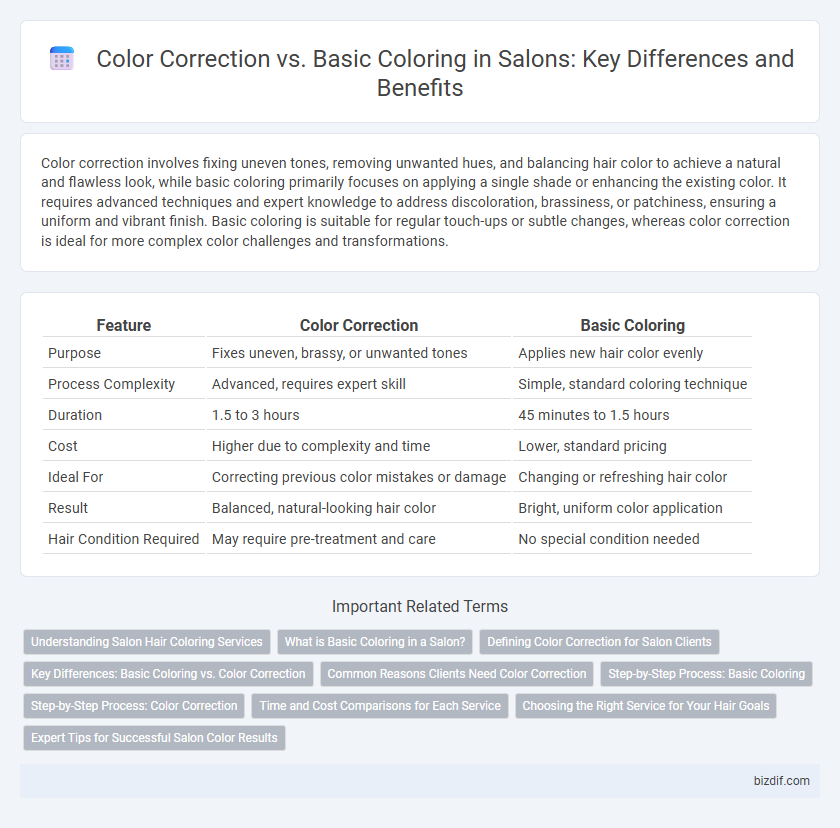Color correction involves fixing uneven tones, removing unwanted hues, and balancing hair color to achieve a natural and flawless look, while basic coloring primarily focuses on applying a single shade or enhancing the existing color. It requires advanced techniques and expert knowledge to address discoloration, brassiness, or patchiness, ensuring a uniform and vibrant finish. Basic coloring is suitable for regular touch-ups or subtle changes, whereas color correction is ideal for more complex color challenges and transformations.
Table of Comparison
| Feature | Color Correction | Basic Coloring |
|---|---|---|
| Purpose | Fixes uneven, brassy, or unwanted tones | Applies new hair color evenly |
| Process Complexity | Advanced, requires expert skill | Simple, standard coloring technique |
| Duration | 1.5 to 3 hours | 45 minutes to 1.5 hours |
| Cost | Higher due to complexity and time | Lower, standard pricing |
| Ideal For | Correcting previous color mistakes or damage | Changing or refreshing hair color |
| Result | Balanced, natural-looking hair color | Bright, uniform color application |
| Hair Condition Required | May require pre-treatment and care | No special condition needed |
Understanding Salon Hair Coloring Services
Color correction in salon hair coloring services involves intricate techniques to fix or neutralize unwanted tones, often requiring multiple steps and precise chemical applications tailored to previous dye or damage. Basic coloring primarily focuses on depositing a single shade to enhance or change hair color uniformly, usually requiring less time and fewer products. Understanding the difference helps clients choose between transformative services and simple color updates for optimal hair results.
What is Basic Coloring in a Salon?
Basic coloring in a salon involves applying a single shade or tone to the hair to achieve uniform color, cover grays, or refresh existing color. This process uses permanent or semi-permanent dyes designed for straightforward, even coverage without extensive customization. Basic coloring treatments typically require less time and technical skill compared to color correction services.
Defining Color Correction for Salon Clients
Color correction in salons addresses unwanted or uneven hair tones caused by previous dye jobs, lightening, or damage, restoring a natural or desired shade. Unlike basic coloring, which applies a single, uniform color, color correction involves multiple steps to neutralize brassiness, blend highlights, or fix patchy results with specialized toner and developer combinations. Professional color correction requires expertise in identifying underlying pigments and choosing tailored formulas to achieve flawless, long-lasting color results.
Key Differences: Basic Coloring vs. Color Correction
Basic coloring involves applying a uniform shade to enhance or change the hair color, often focusing on covering grays or achieving a new tone, while color correction addresses complex issues such as uneven tones, color damage, or previous dye mistakes requiring multiple processing steps. Color correction can include techniques like color balancing, toner application, and strand-by-strand adjustments to restore natural or desired shades without compromising hair health. Understanding the difference is crucial for clients seeking precise hair color results tailored to their unique needs.
Common Reasons Clients Need Color Correction
Clients often seek color correction after unintended hair outcomes such as uneven tones, brassy hues, or color fading occur from previous coloring treatments. Common reasons include fixing color mistakes, adjusting hair color to match the client's desired shade, or repairing damage caused by improper application of basic coloring. Color correction involves complex techniques to restore and perfect hair color, whereas basic coloring typically applies a single, straightforward shade.
Step-by-Step Process: Basic Coloring
Basic coloring in salons involves a meticulous step-by-step process starting with a consultation to determine the desired shade and assess hair condition. The hair is then sectioned, and the color is applied evenly from roots to ends, ensuring thorough saturation for consistent results. After the required processing time, the color is rinsed out, followed by a conditioning treatment to lock in vibrancy and maintain hair health.
Step-by-Step Process: Color Correction
Color correction in salons involves a multi-step process starting with a thorough hair analysis to identify underlying tones and damage, followed by selecting tailored corrective formulas to neutralize unwanted hues. The stylist applies pre-treatments and bond restorers to protect hair integrity throughout the chemical processes, ensuring even color absorption and minimizing breakage. Final steps include toning to achieve the desired shade balance and deep conditioning treatments to restore moisture and shine.
Time and Cost Comparisons for Each Service
Color correction services typically require 2 to 4 hours and cost between $150 and $400 due to the complexity of fixing uneven tones or previous color mistakes. Basic coloring usually takes 1 to 2 hours with a price range of $50 to $150, as it involves applying a single, uniform color for a fresh look. Clients should consider the time investment and budget, as color correction demands more resources but delivers precise results, while basic coloring offers a quicker, more affordable option.
Choosing the Right Service for Your Hair Goals
Color correction targets fixing previous color mistakes, uneven tones, or drastic shade changes, ideal for clients needing a major transformation or repair. Basic coloring enhances natural hair tones, covers grays, or adds subtle highlights, perfect for maintaining or refreshing your look. Selecting the right service depends on your hair's current condition and your desired outcome, ensuring optimal results and hair health.
Expert Tips for Successful Salon Color Results
Achieving flawless salon color results hinges on understanding the difference between color correction and basic coloring; color correction requires precise chemical knowledge to neutralize unwanted tones, while basic coloring enhances natural or pre-colored hair with consistent, predictable shades. Experts recommend thorough hair analysis and strand testing before any treatment to ensure the desired outcome and maintain hair health. Using professional-grade products tailored to specific hair types optimizes vibrancy and longevity in salon coloring services.
Color Correction vs Basic Coloring Infographic

 bizdif.com
bizdif.com